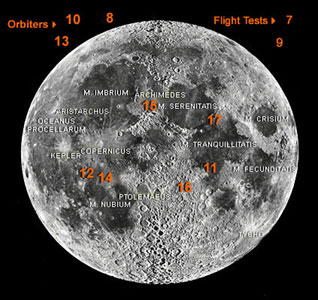Publication of a Paper on the Global Distribution of
Pure Anorthosite on the Moon Detected
by the Multiband Imager onboard the Lunar Explorer
Satellite "SELENE" (Kaguya) in Nature journal
- A New Finding on the Crustal Formation of the Lunar Highland -
Japan Aerospace Exploration Agency (JAXA)
Results of the Multiband Imager (*1) onboard the lunar orbiting satellite "SELENE" (Kaguya) were published in the British science journal "Nature" on September 10 (British Standard Time). As a result of examining the central peaks, walls, and other parts of 69 craters, the Multiband Imager observation instrument team clarified for the first time in the world that anorthosite (*2) consisting of nearly 100 percent anorthite is widely distributed in the lunar highland crust.
The lunar highland crust is believed to have been formed in the earliest stage of the lunar evolution by anorthite crystallizing from a magma ocean (*3) and floating due to the density difference with the magma ocean. It had been conventionally estimated that the lunar highland crust consists of 90 percent anorthite and 10 percent other minerals, wherein pyroxene and olivine also crystallized as well as anorthite. However, this finding has clarified that a new formation mechanism of the lunar highland crust must be constructed, which can efficiently and selectively collect only anorthite in order to form crustal material consisting of only anorthite.
*1: Principal investigator of the Multiband Imager (MI) observation instrument team: Makiko Ohtake, Assistant Professor, Department of Planetary Science, Institute of Space and Astronautical Science, Japan Aerospace Exploration Agency
*2: A white igneous rock rich in minerals called anorthite made of calcium, aluminum, silicon, and oxygen is called anorthosite.
*3: It is believed that after the Moon was formed, there was a period when the Moon became hot and melted to form a magma ocean.
Reference links:
"Nature", science journal: http://www.nature.com/
Japan Aerospace Exploration Agency (JAXA) Lunar Explorer Satellite "SELENE (Kaguya)": http://www.kaguya.jaxa.jp
|
|
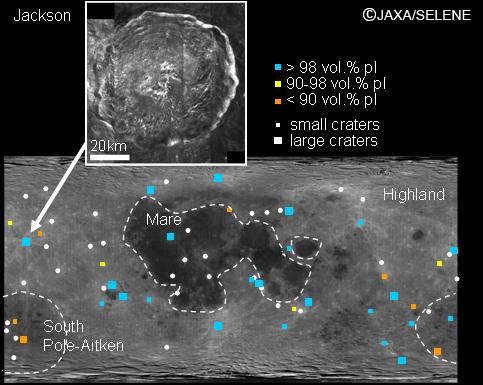
Fig. 1. Result of examining the distribution of highly pure anorthosite by the MI.
(The center of the figure corresponds to the center of the lunar near side. Blue: Highly-pure (purity > 98%) anorthosite, yellow: 98-90 %, and orange <90 %. Small square: small craters (diameter <30 km) excavating the shallow surface, large square: large craters excavating the deeper interior. White circle: spots judged to be inappropriate for estimating the crustal chemical composition because their compositions are possibly altered from that of the original lunar crust due to melting and mixing with surrounding materials accompanying meteorite bombardments.)
From Fig. 1 we can tell that highly pure anorthosite always exists at a depth of 4-30 km in the highland region (indicated as Highland in the figure) where the original crust formed from a magma ocean that was believed to be exposed.
Based on the sizes of the craters examined, the depths of crust excavated by cratering can be estimated to be about 4-30 km.
On the other hand, some of the small craters examined have lesser amounts of anorthite (small squares in yellow and orange) as well as highly pure anorthosite. The reason for this is believed to be that their chemical compositions reflect mixing of the highland crustal material and other various kinds of rocks by meteorite bombardments that occurred on the shallow surface portion of the Moon over a long period. Note that the purity of anorthosite is estimated based on the strength ratios of absorption bands characteristic of individual minerals.
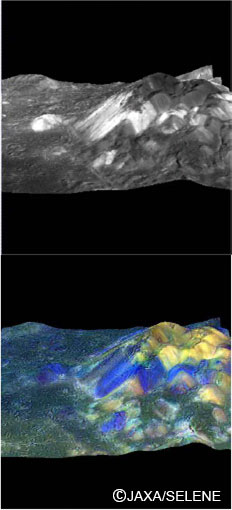
Fig. 2. A bird's-eye view of Jackson Crater (22.4 N / 163.1 W, diameter 71 km) created from geometric information taken by the MI.
A single-band (750 nm) image and a color image showing rock types (the strengths of absorption bands characteristic of individual minerals are indicated in red: pyroxene, green: olivine, and blue: plagioclase)
This is an example of places where large blue squares are plotted in Fig. 1. Blue portions in the rock-type color image are highly pure anorthosite, and their distribution suggests that highly pure anorthosite rocks are exposed only in highly sloped areas.
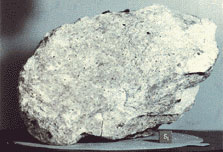
Fig. 4. An example of anorthosite brought back by Apollo 16 (Source: NASA)
Shown in Fig. 4 is a rock that had been conventionally believed to be a sample of a typical highland crust based on the results of examining small portions of the Moon by Apollo missions shown in Fig. 3. Because the anorthite content of this sample is about 90 percent, this is a sample having a lesser amount of anorthite than the highly pure anorthosite found to be widely distributed by the MI this time. Conventionally, the lunar highland crust was estimated to be made of anorthosite consisting of 90 percent anorthite and 10 percent other minerals such as in this Apollo sample. In that case, it was believed that when anorthite crystallized from a magma ocean, not only anorthite but also pyroxene and olivine also crystallized from the magma ocean. However, this finding has clarified that a new formation mechanism of the lunar highland crust must be constructed which can efficiently and selectively collect only anorthite in order to form a crustal material consisting of only anorthite.
As a mechanism to form a crust consisting of highly pure anorthosite, while it is believed that when anorthite crystallizes from a magma ocean, magma trapped in between crystals is pushed out by other anorthite crystals floating up from below, there is another possibility that it was formed by deformation similar to the mechanism that pure anorthosite rocks are formed on Earth. Note that it is believed that the reason why such relatively low-purity anorthosites are found among the lunar rock samples returned by Apollo missions is because such rocks may be samples of lunar surface layers mixed by meteorite bombardments or that low-purity anorthosites exist in some parts of the crust.
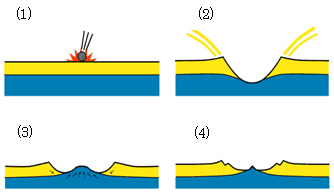
Fig. 5. Formation mechanism of crater central peaks.
Indicated as (1) through (4) are central peak formation processes in a time sequence.
Craters small in diameter come to have a "bowl" shape. When the diameter increases to 30-300 km, a central peak is formed. When a crater is formed by meteorite bombardment (1), first a "bowl"-shape hole is made (2), and a material deep underground is exposed on its bottom (a blue layer in the figure). Then, the central part rises due to a gravitational effect to form a peak (3, 4). This is called a central peak. It is known that the deepest underground material is exposed as the central peak in each crater. The larger a crater is, the deeper material rises from to form a central peak. Therefore, central peaks are called windows to peek at the lunar interior.
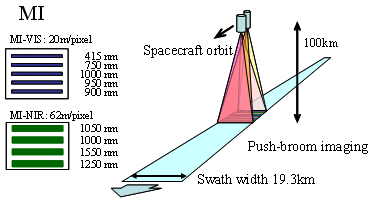
Fig. 6. The MI observation principle and the frequencies and spatial resolutions of the nine wavelength bands.
The Multiband Imager is an instrument that analyzes reflected light with nine observation bands from the visible to near-infrared wavelength range to examine mineral distribution. By comparing images of different wavelength bands, detailed geologic information can be obtained such as the distribution of materials excavated onto the lunar surface by crater formation.
The Multiband Imager has a spatial resolution of up to 20 m, which is one-order of magnitude higher than any lunar spacecraft mission in the past.
